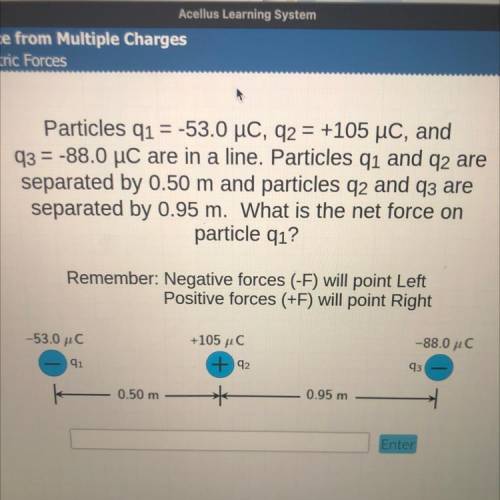
Particles q1 = -53.0 uC, q2 = +105 uc, and
q3 = -88.0 uC are in a line. Particles q1 and q2 are
separated by 0.50 m and particles q2 and q3 are
separated by 0.95 m. What is the net force on
particle q1?
Remember: Negative forces (-F) will point Left
Positive forces (+F) will point Right
-53.0 μC
-88.0 μC
+105 μC
+ 92
91
93
0.50 m
0.95 m


Answers: 1
Another question on Physics

Physics, 21.06.2019 20:30
Ahorizontal wire is tied to supports at each end and vibrates in its second-overtone standing wave. the tension in the wire is 5.00 n, and the node-to-node distance in the standing wave is 6.28 cm. (a) what is the length of the wire? (b) a point at an anti- node of the standing wave on the wire travels from its maximum upward displacement to its maximum downward displacement in 8.40 ms. what is the wire's mass?
Answers: 3

Physics, 22.06.2019 20:30
This is a form of winter precipitation. it is frozen precipitation falling as ice pellets. snowflakes melt into raindrops as they pass through a thin layer of warmer air. the raindrops then refreeze into particles of ice when they fall into a layer of sub-freezing air near the surface of the earth. this precipitation is called a) hail. b) rain. c) sleet. d) snow.
Answers: 1

Physics, 22.06.2019 20:40
Abasketball star covers 2.65 m horizontally in a jump to dunk the ball. his motion through space can be modeled precisely as that of a particle at his center of mass. his center of mass is at elevation 1.02 m when he leaves the floor. it reaches a maximum height of 1.90 m above the floor and is at elevation 0.910 m when he touches down again. (a) determine his time of flight (his "hang time"). (b) determine his horizontal velocity at the instant of takeoff. (c) determine his vertical velocity at the instant of takeoff. (d) determine his takeoff angle. (e) for comparison, determine the hang time of a whitetail deer making a jump with center-of-mass elevations yi = 1.20 m, ymax = 2.45 m, and yf = 0.750 m.
Answers: 1

Physics, 22.06.2019 23:50
An alpha particle with kinetic energy 12.5 mev makes a collision with lead nucleus, but it is not "aimed" at the center of the lead nucleus, and has an initial nonzero angular momentum (with respect to the stationary lead nucleus) of magnitude l = p0 b, where p0 is the magnitude of the initial momentum of the alpha particle and b=1.40×10−12 m. (assume that the lead nucleus remains stationary and that it may be treated as a point charge. the atomic number of lead is 82. the alpha particle is a helium nucleus, with atomic number 2.) what is the distance of closest approach?
Answers: 2
You know the right answer?
Particles q1 = -53.0 uC, q2 = +105 uc, and
q3 = -88.0 uC are in a line. Particles q1 and q2 are
Questions






English, 28.04.2021 02:20

Mathematics, 28.04.2021 02:20

Arts, 28.04.2021 02:20

Mathematics, 28.04.2021 02:20


Physics, 28.04.2021 02:20


History, 28.04.2021 02:20

English, 28.04.2021 02:20

Computers and Technology, 28.04.2021 02:20


Arts, 28.04.2021 02:20





